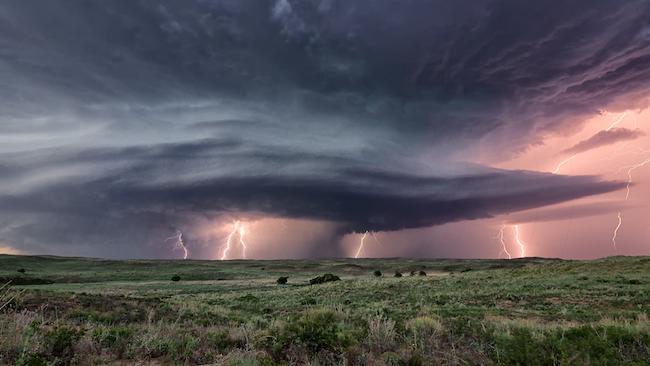The truth about chasing tornadoes
THEY dig metre-long “trenches”, strip asphalt off roads and obliterate entire communities. Welcome to the most dramatic show on earth.

THEY’RE known as the ‘Tornado Titans’ — a group of extreme weather enthusiasts who spend their days getting dangerously close to deadly twisters.
Lead by Chris Sanner, the group capture just how powerful the weather is — and put it on their website for the world to see.
Even though he grew up in tornado prone Oklahoma, Mr Sanner told news.com.au he is still taken by surprise at the power of the storms.
“The motion you see in the videos only captures a small snippet of motion you see in person.
“It’s the most compelling, humbling and scary thing you can ever see. You see that motion, the violence, tearing up anything in its path. You see the whole thing churning, spinning, looking like its ready to eat the whole landscape up.”
While he has been filming his series since 2010, Mr Sanner said there was one ‘close call’ that really stands out.
“The storm that really changed me was when I was trying to be an extreme storm chaser,” he recalled.
“We got really close. We were in a town called Tushka, in Oklahoma, chasing a large wedged tornado that was basically three quarters of a mile (1 kilometre) wide.
“It was moving toward us 30-40 miles (48-64 kilometres) an hour, there were limited roads in the area and we stayed about 30 seconds longer than we should have.
“We had to bail, there were tree branches flying, rocks hitting my car. Escaping that was a very dramatic moment, it was a little more than scary. It’s not worth your life for sure.
“It was one of those humbling moments.”

The Titans were the forefathers of producing the biggest, baddest online tornado content. Their web series, which offers a behind-the-scenes glimpse documenting the crew’s efforts to locate and track the United States’ wildest weather, racked up over half a million hits for their debut season in 2010 alone.
Despite the danger of his work, Mr Sanner reckons the results are worth it.
“It’s the best reality TV on the planet”.
He learned the power of tornadoes from a young age, seeing them rip asphalt from roads, houses from their foundations, and entire communities flattened in one foul swoop.
“Tornados are very violent for sure.
“Being in Oklahoma, you grow up with weather being a part of your life.
“I was that weird kid in school that would spend time looking up at the clouds. If I’d have grown up in California, I’d probably be a surfer, if I grew up in Australia I’d probably enjoy time in the outback. I’m an adventurer at heart and I’m fascinated by nature.”
Oklahoma has seen an unprecedented rise in tornado activity in recent years. This year alone saw its third busiest May on record, with 82 tornadoes ripping through Oklahoma’s peak season. In 2010, a record 91 tornadoes touched down to ground.
Tornadoes form when moist, warm air is trapped underneath a layer of colder, drier air, creating an unstable environment in the atmosphere. When the air warm air rises, it begins to cool and form large clouds and thunderstorms. If conditions are right, the air will begin to spin at speeds of up to and excess of 400km/h, causing the development signature funnel-shaped cloud. The moment it touches land is when it officially becomes a tornado.
“There’s been a little bit of a loss of respect - people aren’t as serious about what tornadoes can do,” Mr Sanner said.
“These things have not gone away in terms of how deadly they are. People die all the time, these are deadly things.
On an average year, Oklahoma sees only approximately 55 tornadoes, but mother nature has eclipsed this number in the last five years. 2015 has already produced 97, and the year’s not over yet.


Yet so frequent are these supercells, Mr Sanner says a new trend is developing within the State.
“Storm chasing is the new sport in Oklahoma, it’s really popular out here. People I know come up with drinking games about this stuff. It’s excellent, dramatic live TV, as horrible as that is to say.”
Meanwhile, the violent, category five 2013 tornado that obliterated the town of Moore reached wind speeds of up to 340km/hour, killing 24 people and injuring 377 others. Its deadly path demolished an estimated 1,150 homes, leaving $2 billion worth of damage. Witnesses described it as “a giant black wall of destruction”.
“It was so destructive here in Oklahoma,” described Mr Sanner. “To see that destruction first hand, if you are a human being you can’t help but feel empathy.”
“It’s always the challenge with storm chasing, realising that you should shoot the story well and get the story right, but you can never forget that human beings are on the other side of this.

For more information about Chris Sanner and his team of tornado chasers, visit the Tornado Titans website or follow them on Twitter @TornadoTitans.
- youngma@news.com.au



